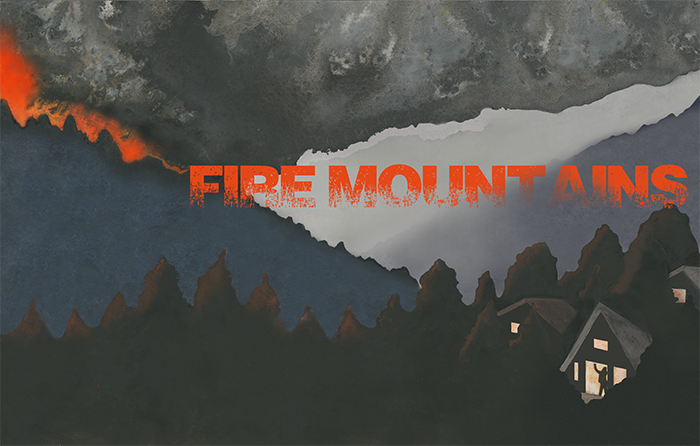
|
| Illustration: Kayla Kemper |
Decades of suppression have made Sierra Nevada wildfires far more intense.
Ramin Skibba hikes in to see the impacts. Illustrated by Kayla Kemper.
On a bone-dry day in August 2013, Kate Wilkin and her fellow fire science students ventured into the dense Stanislaus National Forest in the western Sierra Nevada. They scrambled over roots and fallen trees to identify pines and firs, measure their sizes, and gauge their fuel potential for wildfires.
Then, from a clearing they spied smoke rising above the canopy. A fire was bearing down on them. The Forest Service called the students on their radios, and they scrambled to pack up and evacuate the camp.
That blaze exploded into the biggest recorded fire in Sierra Nevada history. The “Rim Fire” consumed more than 400 square miles and incinerated the students’ patch of forest. The fire was devastating for one reason, researchers believe: These woods hadn’t burned for a century. Now, too much of the state is a similar tinderbox.
When the U.S. Forest Service first surveyed the area in 1911, widely spaced giant pines ruled the same slopes. Under those conditions, wildfires were short-lived and less severe, and many trees survived. Today, smaller and more flammable trees crowd these woods, says Scott Stephens, Wilkin’s advisor and director of the Center for Fire Research and Outreach at the University of California, Berkeley. “California is in a fire deficit,” he warns.
Indeed, half of the state’s largest recorded fires have erupted during the past decade, according to Cal Fire, the state’s protection agency for private and public forests. Stephens and his team have found that Rim Fire–sized events never occurred in the past, but they are becoming increasingly common. As climate change quickens and droughts lengthen, this could be a sign of a new normal.
For decades, the Forest Service’s policies reflected the public’s aversion to fires. Firefighters zealously extinguished every one immediately after spotting it. Now, researchers like Stephens are pressing authorities to manage fires, rather than fight them all. The agency appears to be listening. Its new land management plans, being updated in a process that began in 2012, recognize the importance of letting naturally occurring smaller fires burn through debris in Sierra Nevada forests.
But in California, those policies are just half the challenge. When people build homes in fire-prone areas, Cal Fire’s mandate is still to suppress any blaze to protect lives and property—at great cost and risk to firefighters themselves. It’s time for that to change, scientists and forest managers argue. The state’s rural citizens must build differently and view fires as a fact of life, they say, or risk becoming a low priority for firefighters when the next inferno arrives.
Forests in transition
Early surveyors in the Sierra Nevada saw very different forests and landscapes than we’re familiar with today. Systematic measurements showed that massive ponderosa pine and other mixed conifer trees stood 20 to 30 feet apart. Shrubs and other vegetation dotted the wide swaths between them. “If you went to a forest back in 1911, you’d probably have to wear a sun hat all the time,” says Stephens.
As the century progressed, small trees began to fill those gaps. Tree density in ponderosa forests has more than quadrupled, according to Stephens’s research.
Trees remember their history. Wildfires scar the trees that survive, searing a record of their past into the wood. By examining such scars, Stephens and his colleagues estimate that at least four million acres burned in an average year in California two centuries ago. Lightning ignited many of those fires, while Native Americans set others. “California is called the Golden State,” Stephens says, “but I call it the Pyro State.”
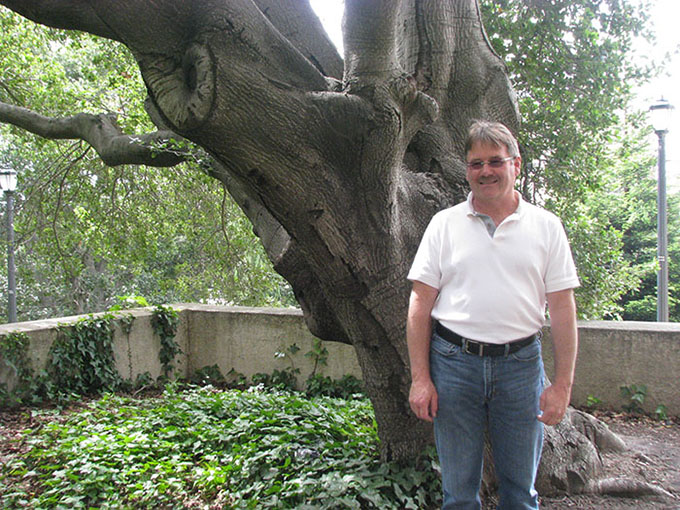 |
| Photo: Ramin Skibba |
| UC Berkeley fire scientist Scott Stephens. |
|
But that was then. Cal Fire now calls it a “bad” year when more than a half-million acres burn. The fires that escape firefighters are more intense, killing almost every tree in their paths. Monster wildfires like the Rim Fire and the King Fire, which scorched more than 150 square miles in 2014, are a new phenomenon, says Stephens. As fires worsened, the agencies ramped up fire suppression. The efforts ate up billions of dollars—the majority of the Forest Service’s annual budget. “If you look at the cost of suppression from the 1980s until today, it has doubled every decade,” Stephens observes.
On top of these trends, warming temperatures and persistent droughts have begun to transform and damage Sierra Nevada forests. Last year, geophysicists showed that greenhouse gas emissions have intensified California’s drought. If the pattern continues, the region likely faces “mega-droughts” in the future. Denser forests retain less water and drought-weakened trees are more vulnerable to wildfires, argues Roger Bales, director of the Sierra Nevada Research Institute. “The way we’re managing the forests is not sustainable,” he says.
Burning science
To understand how today’s forests respond to fire, researchers have to set some of them alight.
Stephens and his students periodically perform fiery experiments in the University of California’s Blodgett Research Forest. The 4,300-acre plot, east of Sacramento, lies within a mile of where the 2014 King Fire burned the El Dorado National Forest.
During a visit in March, the mountains above the team still carry a heavy layer of snow. The fire season has not yet begun. It’s not windy, and the risk of an uncontrolled fire is slim. Under these conditions, Stephens and his students ignite “prescribed burns”—fires intended to remove fuel for dangerous wildfires in the future. In other areas, they use machines for “mechanical thinning,” which splinters and cuts up trees and tree limbs. The debris will decay over time. This too is designed to reduce fuel when the next wildfire comes along.
It may seem counterintuitive to cut down and burn parts of a forest in order to save it. But the goal is restoration and resiliency, Stephens says. A thinned-out forest can better survive a fire, as well as a four-year drought or an attack by bark beetles.
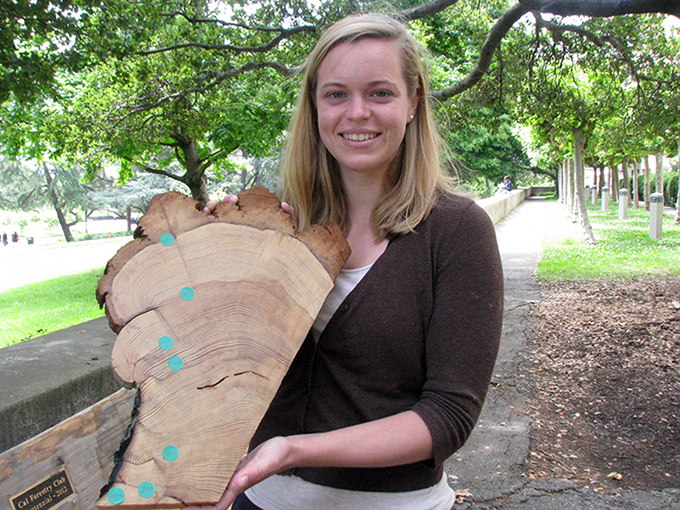 |
| Photo: Ramin Skibba |
| UC Berkeley policy analyst Carlin Starrs with a fire-scarred cross-section of a cedar tree. |
|
Carlin Starrs, a policy analyst working with Stephens and his team, displays a sample of a fire-scarred incense cedar tree that survived. It’s a thick slab of the tree’s charred trunk. Hundreds of growth rings undulate around, some with telling indications of fires past. Massive trees indeed survive fires, she says. This one made it through seven fires dating back to 1858 and lived. “I think ecologically there’s a strong argument for prescribed burning in these forests,” says Starrs.
Even trees that do not survive can produce waves of seedlings after a fire. These seeds can persist in the soil or in resin-sealed cones that open up and disperse their bounty on the ground, like arboreal Johnny Appleseeds. In time, these regenerate the forest.
Stephens has a framed photograph of such a forest revival on his wall at UC Berkeley. In an area within Yosemite National Park that burned in the 2001 Hoover Fire, responders allowed the fire to burn an acre or two instead of quickly snuffing it out. Many trees survived, but even where they didn’t, small seedlings, grasses and goldenrods began to restore the forest. They flourished like spring blooms after a long winter.
Today, Sierra Nevada forests burn less frequently and more intensely and severely than in the past, Stephens and his colleagues have shown. In a 2015 paper published in Ecosphere, they reported that not only are forests more densely packed now than in 1911, but the canopy cover has increased, the forest structure looks less varied, smaller trees have replaced giant ones, and the mix of tree species has changed dramatically.
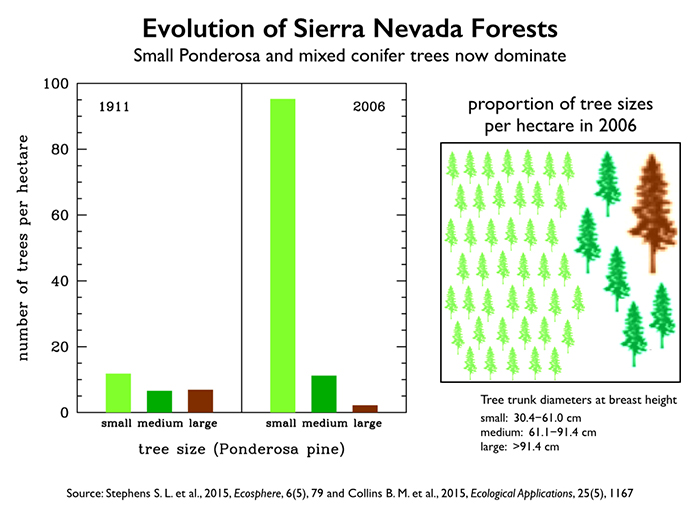 |
Graphic: Ramin Skibba |
Stephens argues that forests adapt differently to “fire regimes” in their areas depending on the natural conditions and tree species involved. For example, lodgepole pines in the high-elevation Rocky Mountains have adapted to rarer, higher-severity fires. In Western Australia, which closely resembles the Sierra, foresters ignite prescribed fires to burn more than 6 percent of the forests each year. That region has almost no severe fires, he says.
The evolving Sierra Nevada forests and frequency of severe wildfires might not originate entirely from suppressing fires and accumulating fuels. In addition to overly aggressive forest management, climate change and drought have made forests more flammable, argues Anthony Westerling, an environmental engineer at UC Merced. “We’ve made a perfect storm: We’ve created the fuels and then dried them out,” he says.
Westerling and Stephens agree that more enlightened policies would have helped forests weather today’s hotter and drier conditions. “If you could magically wave your wand and restore those fuels to the way they would have been without a century of fire suppression,” Westerling says, “these forests would be way more resilient to climate change.”
Kindling responses
Many events set off wildfires: lightning strikes, fallen power lines, smoldering campfires, and anything else that could create a spark. Regardless of the cause, fires will burn in the hot and dry Sierra Nevada summers. Stephens believes the next few decades will be critical to tamping down California’s worst fire threats. “You could make a difference in 30 years if you brought a really focused program,” he says. “There’s no doubt you could. That’s my hope.”
Such a program could take many forms. In the Forest Service, managers of individual forests—starting with Inyo, Sequoia and Sierra National Forests—are updating their land management plans for the first time since the 1980s. The revisions would “increase the area where fuel reduction treatments occur while also increasing the opportunity to use fire as a restoration tool,” the Forest Service website states. For Stephens and other fire scientists, this is a big step forward.
“Fire has been such an essential part of this landscape for thousands of years,” says Don Yasuda, an analyst for the Forest Service’s Pacific Southwest Region. But because of the risks and impacts of prescribed and managed fires, “we have to be thoughtful and careful about how we do this,” he says.
Some people have come to accept these purposeful burns. But smoke from managed fires can have unintended consequences for public health. Larger ones can violate current U.S. Environmental Protection Agency air-quality restrictions on ozone and other harmful pollutants. Every time smoke drifts from the mountains into California’s populated valleys, residents raise concerns about respiratory conditions and children who have asthma. Carlin Starrs, the policy analyst, seeks to weigh these complex issues while pressing the EPA to update its rules. The effort is working: EPA regulators now recognize the need to account for expected emissions from prescribed fires.
To move forward, these agencies need public input and support, says Malcolm North, an ecologist at UC Davis and the Forest Service’s Pacific Southwest Research Station. But the cultural shift is a challenge. “Fire suppression has given the sense that wildfires don’t occur very often and that you can put them out,” North says. “It lulls people into a false sense of security.”
People who settle near earthquake faults or hurricane zones seem more aware of the risks and the need to take precautions. For those living in fire-prone areas, however, “the dominant view is that we fight wildfires,” says Santa Barbara–based fire scientist Max Moritz. Residents don’t see them as a natural part of the landscape, he observes.
|
Ramin Skibba hikes into the Sierra Nevada with UC Berkeley fire scientists, who use controlled burns and mechanical tree thinning to try to lower fire hazards in the dry forest. Click on image to play. |
Kate Wilkin, Stephens’s graduate student, acknowledges that she sees fires differently when they’re looming, as in her 2013 evacuation. “My perception of fire changes with the moment,” she says.
Wilkin demonstrates basic fire physics with matchsticks that represent trees. Closely spaced matches—like a dense forest—ignite one another and burn quickly. For widely or intermittently spaced matchsticks, the fire fades and spares many of them. Then, by placing matches on a tilted board, Wilkin shows how fires rapidly sweep up steep slopes. The implications for where not to build homes are clear. She wants to figure out how people and fire can live together at the margins between communities and wildlands. It may be possible to encourage such residents to view smaller periodic fires as naturally occurring events, Wilkin believes.
But too many homes cannot withstand fire, and newcomers moving into California may not be aware of the dangers. The number of homes built in areas prone to fire has soared by 60% since 1970. “The crux of the problem is that we still have a focus from the Smokey Bear ad campaign: With enough diligence and effort, we can put out fires whenever we want to,” says North. “That’s just not true.”
Fighting burnout
As a first step, fire managers should talk to and better engage with residents of fire-prone landscapes, says Stacey Frederick, California Fire Science Consortium coordinator in Stephens’s lab. She works on creating partnerships between local Fire Safe councils and the national Firewise Communities Program, raising awareness and making towns less vulnerable to severe fires.
“There’s a good chance that when fire does come, there won’t be a fire engine in your driveway. The Fire Service can’t be everywhere,” says Christopher Dicus of the consortium. Small measures help, like retrofitting homes and buildings with fire-resistant materials and ember-proof vents. Residents also should “prepare the battlefield,” he says, by clearing trees and bushes that can hinder firefighters. Those in the most hazardous areas may have to move.
Meanwhile, climate change continues to alter California’s fire regime. Bill Stewart, co-director with Stephens of the Center for Fire Research and Outreach, asserts it is no longer possible to return the forest to a pre-settlement state. Instead, Sierra Nevada forests and residents must adapt, Stewart says. We can expect less snow in the Sierra and longer, hotter fire seasons. Weakened trees will become more vulnerable to bark beetles, disease and wildfires. The forests have already been driven beyond their natural fire conditions, to which they had adapted for centuries before settlers arrived, he argues.
If we do nothing, Stephens predicts, the state’s forests will become smaller. Big patches of dead trees will spread, and some areas will become shrublands. Invasive species that like open areas will take over. But if agencies change their management policies on a large scale within the next few decades, he argues, this future could be averted.
Amid the debates, policy adjustments, and the specter of calamity, people continue to love the Sierra Nevada and to live there—often for decades or generations. Clancy Nielsen, a lifelong denizen of the Eastern Sierra and former Wilderness Trail Crew Leader in the Inyo National Forest, now thinks about fire more often than he would like. “I grew up in the mountains, choosing to spend my life in them and devoting my work to protecting them,” he says. “I feel like the increased risk of fires is a sign that my little world is changing in ways that feel threatening.”
© 2016 Ramin Skibba / UC Santa Cruz Science Communication Program
Top
Biographies
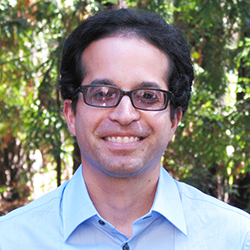
Ramin Skibba
B.S. (physics), B.A. (philosophy) University of Notre Dame
Ph.D. (physics & astronomy) University of Pittsburgh
Internship: Nature (Washington, D.C.)
In grade school, my friends called me “Mr. Encyclopedia.” I memorized hundreds of digits of π, quoted Star Trek characters, and read as many books as I could carry on my back. Later, Carl Sagan’s Cosmos, the dazzling night sky above the Colorado Rockies, and many excellent and eccentric teachers propelled me into astrophysics. My insatiable curiosity also spurred me into sociology, political science, and philosophy.
During 15 years as a research scientist I analyzed the structure of the universe, zoos of galaxies, disparate views on dark matter—and our place among these wonders.
My work in public outreach, teaching, citizen science, and policy advocacy steadily pulled me toward communicating science. My explorations and investigations continue, but the stories themselves draw me onward, just as powerfully as Sagan and my teachers did years ago.
Ramin Skibba’s website
. . . . . . . . . . . . . . . . . . . . . . . . . . . . . . . . . . . . . . . . . . . . . . . . . . .

Kayla Kemper
B.A (art) University of California, Santa Cruz
Internship: Seymour Marine Discovery Center, Santa Cruz
Kayla Kemper is an artist based in Santa Cruz. Growing up along the California coast, she was fascinated by marine ecosystems and started volunteering at local aquariums. Kayla developed an appetite for exploring nature, which would later fuel her art practice. During her time as an undergraduate, she used photography and sculpture to find out more about what it means to be human and connected to nature. Science illustration became an outlet that allowed her to continue asking questions to further develop her understanding of nature. Kayla hopes to develop visual media for parks, museums, publications, and organizations that inspire nature stewardship.
Kayla Kemper’s website
Top |

